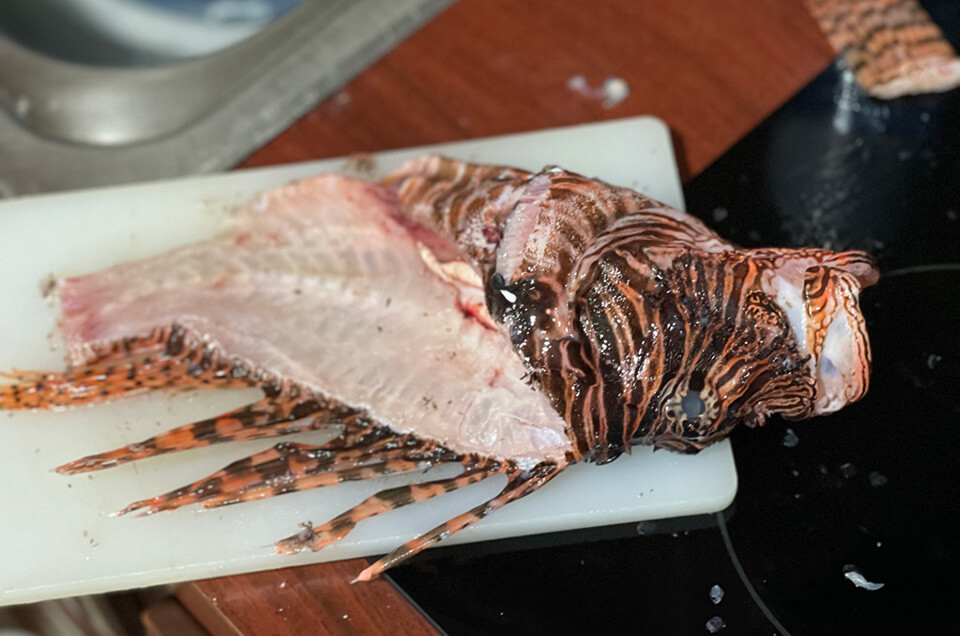How to Eat Lionfish

Eating lionfish is becoming more popular. And as people become educated about the dangers of invasive lionfish and the pleasures of eating lionfish, demand is sure to rise. Restaurant chefs, recreational divers, home cooks, and fans of fish dishes will be cooking and eating lionfish in greater numbers. By taking necessary precautions when hunting, purchasing, cleaning, and cooking lionfish, it can be a safe and delicious addition to your diet. Lionfishdivers.com provides educational information about the lionfish invasion and promotes the hunting and consumption of lionfish.
As an invasive species, it has become clear that lionfish are damaging our underwater environment. Escaping from aquarium hobbyists or hitching along transatlantic shipping routes, lionfish have spread away from their native habitats between the South Pacific and Indian Oceans. As can be seen in our lionfish flip book, the population has exploded, and these predatory fish are eating many varieties of fish and seafood found along the Atlantic Seaboard and in the Caribbean. Their predation may be particularly noticeable to humans who visit coral reef environments, such as dive enthusiasts. This is one of the factors that has led Lionfishdivers.com in its mission to promote lionfish hunting.
Here, Lionfishdivers.com explains how to prepare lionfish safely and create delicious, healthy meals.
How to Clean Lionfish
Like any other fish, the lionfish must be cleaned before it can be eaten. However, this process is a bit trickier with lionfish due to their 18 large, venomous spines. As can be seen in Lionfishdivers.com’s collection of lionfish cleaning videos, it’s important to protect your skin from being stabbed or injected by one of these spines. Here are the steps to take when cleaning a lionfish:
- Wear thick gloves, preferably puncture-proof.
- Use sharp tools and cut away from your position.
- Set up in a work area that is easy to clean, with enough room for handling the fish.
- With large kitchen scissors, sharp shears, or a sharp filet knife, cut off the wings of the lionfish. These can be discarded or fried for a crisp snack.
- Next, cut off the top spines on the dorsal fin with a nice, smooth cut close to the body of the lionfish.
- Continue to cut away the spines located on each side of the pelvic fin and the three spines in the anal fin.
- The tail can remain on the fish if desired.
- Cut along the spine of the fish from tail to head.
- Remove the stomach and internal organs.
- Remove the head.
Remember to keep the cleaning area cleared of spines and other discarded parts of the lionfish. As you clean the lionfish, place the cleaned bodies on ice, ready for further preparation. As you clean the lionfish, you might see partially digested remains of recent meals. These busy predators eat shrimp, lobster, and small tropical fish, as well as some larger fish.
How to Prepare Lionfish
After the lionfish has been hunted, caught, and cleaned, it’s time to prepare it for cooking. The skin is thin and can be peeled away from the flesh fairly easily if desired. To filet the lionfish, peel away the meat from the bones in the spine. Once you have removed the venomous spines and gutted the lionfish, any further preparation depends on how you’ve chosen to cook it.
How to Cook Lionfish
Eating lionfish can be a wonderful adventure. That’s because this versatile fish can be cooked in a large variety of ways. As with any cooking ingredient, any sides and sauces served with the main dish can greatly influence the presentation of the meal.
One of the most common ways to prepare lionfish is as a filet. The skin is removed, and the meat is cut into small portions. A more flamboyant presentation is made when the whole fish is cooked by roasting or grilling. Chefs and adventurous home cooks may leave the fins on the fish, as well as the head for dramatic flair. Asian cooking traditions have a long history of preparing whole fish with the head, promoting the freshness and beauty of the meal.
Types of Lionfish Recipes
The types of recipes cooked at home are often less elaborate than those provided by restaurant chefs. While both kinds of cooks prepare lionfish as a healthy food for patrons and families, obviously the type of recipe depends on cooking ability, experience, and ethnic influences.
The latter can be seen in two common types of lionfish recipes, sushi rolls and ceviche. We also offer classic French preparation with a Meuniere-style lionfish recipe. Our friends at Roatan Divers offer a recipe for coconut curry made with lionfish that also looks delicious. Here are some other suggestions for different types of lionfish recipes that can use a variety of seasonings and spices:
- Breaded and fried filets
- Stir-fried vegetables with cubed lionfish
- Risotto topped with lionfish
- Whole fried or grilled lionfish
- Braised or poached filets with wine sauces
- Stuffed, baked filets with mushroom or tomato sauces
- Minced and mixed with breadcrumbs and seasonings for fried fish cakes or croquettes
- Salads or cooked greens topped with poached or fried lionfish cubes
Why Eat Lionfish?
Eating lionfish is good for our environment. The ocean is becoming depleted of fisheries, due to overfishing and ecological issues, such as pollution and climate change. The lionfish invasion is adding to this depletion, bringing its large appetite and ability to procreate at a fast pace. When divers are engaged in hunting lionfish for sport and to benefit the health of oceans and coral reefs, they are also providing fresh, delicious, healthy fish to tables around the Atlantic and Caribbean oceans.
This fresh fish is also a healthy source of Omega-3 fatty acids and is low in heavy metal concentrations. As a light, flaky whitefish it is useful in many recipes, and it substitutes well in most cuisines. With so many of the world’s human populations seeking out fish to include in their diets, the addition of lionfish is a fitting solution in areas where it is considered a dangerous, invasive species.
Become an Advocate for Eating Lionfish
Once you start eating lionfish, you’ll discover how much taste and health it adds to your diet. The next step is to become an advocate for more people to eat lionfish, and for it to be included in restaurant menus. When dining out, don’t be shy about requesting lionfish, or explaining to the chef how you would order it if it was included on the menu. Share lionfish information with friends and family members, explaining how eating lionfish is helping to clear local ocean environments of harmful predators while providing high-quality food.
Join Lionfishdivers.com in our mission of helping to restore Atlantic and Caribbean coral reef environments by reducing the population of lionfish. We promote hunting and eating lionfish as a fun way to enjoy scuba diving, benefit the environment, and enjoy a good meal.
Learn About How to Hunt and Eat Predatory Lionfish
We encourage you to find out more information about this harmful, but delicious species. Divers, environmentalists, and cooks are welcome to join our efforts. You can get answers to your questions at Lionfishdivers.com or contact us today.





